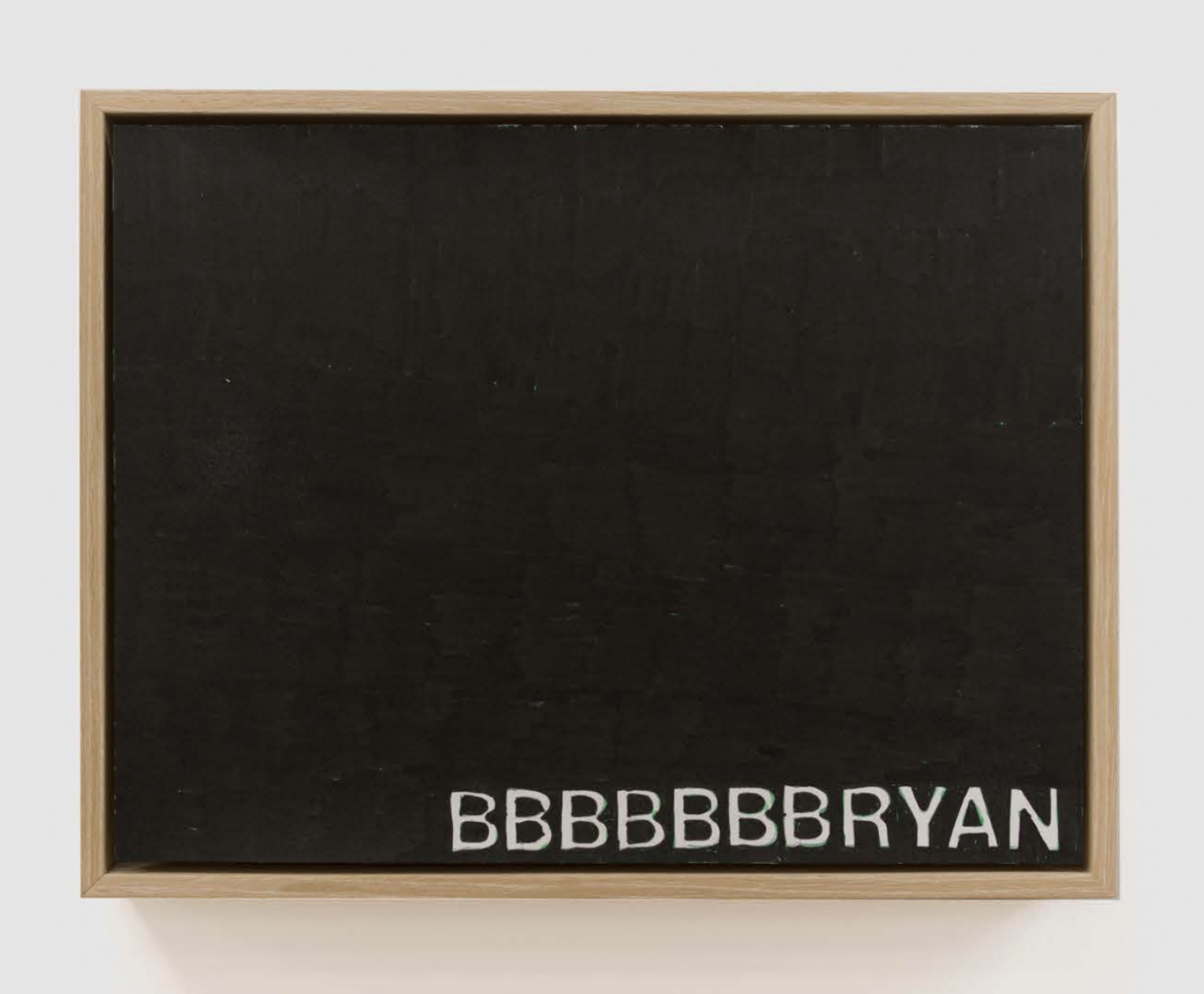BBBBBBBRYAN: Anti-Language, Anti-Painting
Bryan Castro’s solo exhibition to stutter / to atomize / to interrupt, on view at D. D. D. D., is a noisy, nervy, profoundly destabilizing show, which is to say that it is incredibly alive. Castro’s tools are acrylic, oil, ink, paper, canvas, and language, but they aren’t deployed towards clarity in imagemaking. Instead, they fumble, glitch, and scramble. They stutter. The result is a body of work that feels like it's fighting to speak and then, just as urgently, undoing the act of speaking.
The show’s title is its thesis: stuttering, atomization, and interruption. These are not just linguistic metaphors, but formal strategies. In Castro’s hands, the visual field is rendered uncertain. The artist plays with his own name, “BBBBBBBRYAN,” fragmenting it into a kind of semantic feedback loop. Other works incorporate song lyrics, phrases, or aphorisms, but they are scrambled or misplaced, made to feel uncanny. A line lifted from Miguel’s song “Sure Thing”—“you can / be the chalk / and I / could be the / blackboard”—flickers in one piece, gnawed at its edges by a holographic virus, not quite fully digested. The line is poignant, romantic, but the karaoke lettering is the wrong color, grey, like it’s been pulled as a ghost from the wrong moment in time. The lyric doesn’t land. It hovers in prismatic corruption.
This sense of dislocation runs throughout the exhibition. In one room of the gallery, drawings and paintings hang in a serialized lineup—a procession of karaoke lyrics punctuated by jarring, urgent, emotional images, subliminal fragments of imagery, and digital interference. Some of the drawn works, aggressively filled with a kind of pressing human need, evoke the visual forms of Philip Guston in their raw cartoonishness and claustrophobic forms. Others feel like scratchings or flares of a fevered mind, acidic and overclocked. Text lines itself up dutifully and then disappears into darkness, which sometimes reads as mourning and sometimes as refusal. One sees and unsees.
Damien Ding, the owner of D. D. D. D., calls the show a kind of “anti-painting,” and I think that’s apt. Castro often references art historical forms only to disarm them. The familiar composition of a woman gazing before a mirror is turned putrid among other art history cliches. There’s a painterly sensibility at work here, but it’s constantly being antagonized by language, by repetition, and by a specter of the digital. Karaoke, after all, is a kind of secondhand language, a voice borrowed, a performance of a performance, and Castro uses it as both method and metaphor. It appears in several works under the recurring title “Presupposing the mouth as a musical instrument,” but rather than affirming vocal agency, the text is disintegrated, abstracted into a techno-glitch. The voice disappears, and the words hang half-chewed in the air without an anchor.
What makes this show more than just a formal experiment in textual aesthetics is the palpable emotional register underneath it. Ding describes the work as containing “frustration and desperation to communicate,” and I feel that too; however, alongside it, I sense a kind of mourning, not only for the breakdown of language, but for what gets lost in that breakdown: access, fluency, recognition, and time. Sometimes, the work insists on presence by being loud, repetitive, and defiant. Other times, it dissolves at the edges, its boundaries bleeding into rainbow confetti or static. Castro is aware that to stutter is not just to speak differently, but to be heard differently. It’s tempting to try to decode Castro’s work, to translate the fragments into some coherent narrative. But that would miss the point. The work resists cohesion. It atomizes not just language, but interpretation itself. This is a show about the image breaking down, the word unraveling, the voice flickering in and out of register. In doing so, it renders visible the labor of trying to say something when the available forms are already exhausted or faulty.
Ultimately, “to stutter / to atomize / to interrupt” is about the poetics of rupture. Castro treats stuttering as a radical aesthetic tool. Through interruption, he opens space. Through fragmentation, he builds meaning. Through a refusal to resolve, he makes art that is insistently present, even as it slips away.
Bryan Castro: to stutter / to atomize / to interrupt is on view at D. D. D. D., New York, from May 9th to June 15th.

![Bryan Castro, Untitled Re-Mix, Part 1 ([Bryan or] B, / You / you say / things / the wrong way) (2023-25). Acrylic and graphite on canvas, 16 x 20 inches, courtesy of the artist and D.D.D.D.](https://images.squarespace-cdn.com/content/v1/660b55f67497fc4f126f099f/bff2df2e-f02a-454d-8c8f-418502ae6d7c/Untitled+Re-Mix%2C+Part+1+%28%5BBryan+or%5D+B%2C+_+You+_+you+say+_+things+_+the+wrong+way%29%2C+2023+-+2025+Acrylic+and+graphite+on+canvas%2C+16+x+20+inches.jpg)





